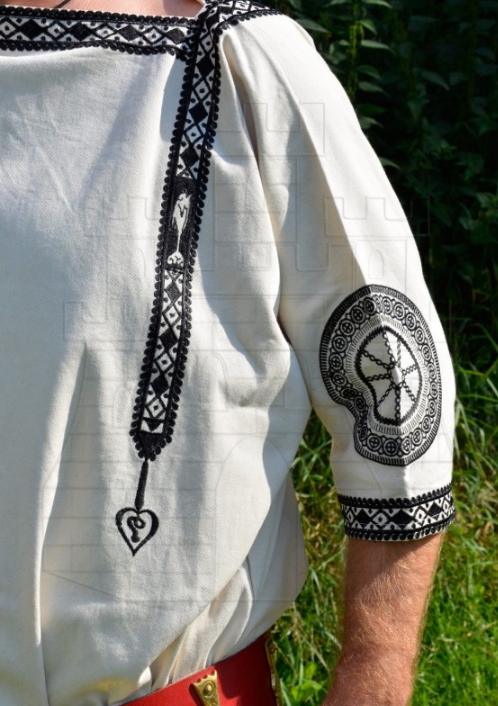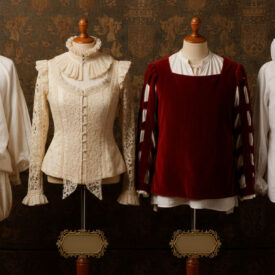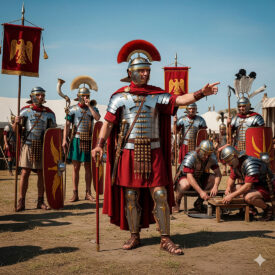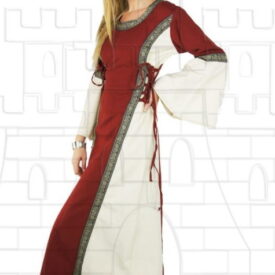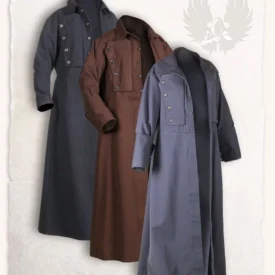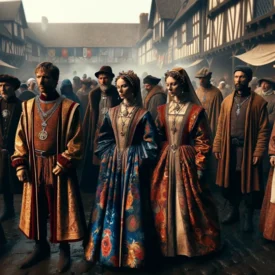The Roman tunicata manicata is much more than a garment: it is a window into the aesthetics, hierarchy, and daily life of ancient Rome. Its evolution from a marginal piece to a central element of the wardrobe demonstrates how fashion reflects social, technical, and religious changes. In this article, we will explore in depth what the Roman tunicata manicata was, how it was made, what its decorations meant, and how to recreate it today with historical and functional criteria.
Origin and historical context of the Roman tunicata manicata
The tunic was the basic garment in Rome for centuries. The manicata version —literally “with sleeves”— is distinguished by the inclusion of sleeves that could vary from short to long. In early classical Rome, long sleeves were often associated with foreigners or with styles that purists considered effeminate, but that perception changed over time.
From the 3rd and 4th centuries A.D. onwards, and after administrative and social reforms such as those implemented by Diocletian, the tunica manicata became popular among different social strata. Its adoption by sectors of the army and the elite indicates a transformation in aesthetics and functionality: clothing went from being primarily enveloping to sewn and more fitted garments.
The spread of the manicata also reflects innovations in textile techniques and raw material trade. The introduction and increasing access to silks, dyes, and brocades allowed the tunic to become a medium for social communication: the presence of clavi, orbiculi, or paragauda indicated position, privilege, or cultural belonging.
Design, confection, and practical aspects
From a technical point of view, the Roman tunicata manicata follows three principles: simplicity in cutting, comfort for everyday use, and the ability to display status when appropriate. The traditional pattern was almost always rectangular, with pieces sewn laterally and openings for the sleeves. This economy of cutting allowed garments to be produced in series with minimal fabric waste.
The placement of the tunic obeyed practical rules: it was cinched with a cingulum or belt to control the drape and create folds that facilitated movement. The belt was not only practical; it could also be a distinctive accessory made of materials such as leather, fabric, or metal.
The sleeves of the manicata varied: versions with short or elbow-length sleeves were common in domestic and urban environments; long sleeves appeared in higher-status garments or colder climates. A frequent aesthetic detail was that the back of the tunic was slightly longer, a small gesture that denoted care and good taste.
Technical features
- Rectilinear pattern and discreet side seams.
- Sleeves in short, elbow-length, or long variations depending on the era and use.
- Variable length: from knee-length for military to ankle-length for high-status women.
- Applied embellishments on the neckline, chest, sleeves, and hems to mark rank.
Evolution of patterning: from T-shape to progressive tailoring
Until approximately the 7th century, the dominant pattern was the “T” shape: straight pieces, few seams, low technical difficulty. From the 7th century onwards, and especially towards the 8th, tunics underwent modifications: more fitted cuts, attached rectangular or trapezoidal sleeves, and the introduction of lateral gussets that favored a subtle flared effect.
These changes were not merely aesthetic. They responded to new social needs —greater mobility, gender, and status distinction— and the availability of more flexible fabrics and advanced tailoring techniques. The more frequent use of wool and the emergence of polychrome brocades transformed the garment’s overall appearance.
Decoration, symbols, and social meaning
Ornamentation was a visual language that allowed identifying origin, rank, and beliefs. Techniques varied from simple tapestry and weaving to embroidery with gold threads. Among the most relevant decorative elements are the clavi, orbiculi, gammulae, and the paragauda.
- Clavi: vertical stripes that marked status; the tunica laticlavia was an example of senatorial use.
- Orbiculi / tabulae: circular or square medallions on shoulders and hems.
- Gammulae / gammadiae: angular bands and foliate finishes.
- Paragauda: silk and gold embroidery, reserved for consuls and dignitaries.
The represented motifs also had a symbolic and protective character: Dionysian, Nilotic, geometric scenes, Sasanian motifs, and, over time, Christian themes. This iconographic variety evidences cultural contacts with Egypt, Persia, and the Byzantine world, as well as the adaptation of religious images in civil and ecclesiastical contexts.
Varieties, social labels, and examples of use
There was not a single “tunica manicata” but a range of variants that responded to different functions. The augusticlavica and the laticlavia are examples of how one or two purple stripes could transform a common garment into a symbol of power.
In daily life, legionaries preferred practical, short cuts that would not hinder marching or combat. Artists, gladiators, and laborers could adapt the length and an exposed shoulder for practical or scenic reasons. Nobles and officials, on the other hand, wore fine fabrics and complex decorations that communicated their status.
Real examples and use
- Citizens and officials with status details according to their position.
- Legionaries with sturdy tunics and strategic length.
- Gladiators and artists with adaptations for movement and visual effect.
Materials, colors, and dyeing techniques
Tunics were primarily made of wool or linen; silk was a luxurious material reserved for the elite. Natural tones —beige, cream, brown— were common, while intense purples and reds required expensive pigments and, therefore, were associated with power.
The laticlavia and augusticlavica stripes could be woven in or applied, which required technical skill. Over time, polychromy and brocade became dominant, introducing complex motifs of Sasanian and Egyptian influence. In addition, many motifs had an apotropaic value, meaning they were believed to protect the wearer.
The tunicata manicata in the military and ceremonies
In the military field, functionality was paramount: sleeves that did not interfere with weapons, durable fabrics, and cuts that allowed freedom of movement. However, in ceremonies and administration, the manicata could appear in richly decorated versions combined with the toga praetexta or other insignia.
The coexistence of practical and ceremonial use illustrates the garment’s flexibility: the same basic structure could be adapted to numerous social needs.
How to recognize and recreate an authentic tunicata manicata
If you want to replicate a Roman tunicata manicata with historical accuracy, consider these basic principles:
- Simple pattern: rectangular pieces, side seams, uncomplicated cut.
- Sleeves: short or elbow-length for the manicata; avoid modern volumes at the shoulder.
- Length: adapt according to function: shorter for military, longer for civilians.
- Rank details: purple stripes or embroidery depending on the status you wish to represent.
- Belt: essential for faithful recreations; it determines the drape and folds.
For materials and patterns, we recommend checking out models in our online store where there are options that respect historical proportions and modern sizing for comfort. Many replicas incorporate reinforced seams and discreet linings without sacrificing aesthetics.
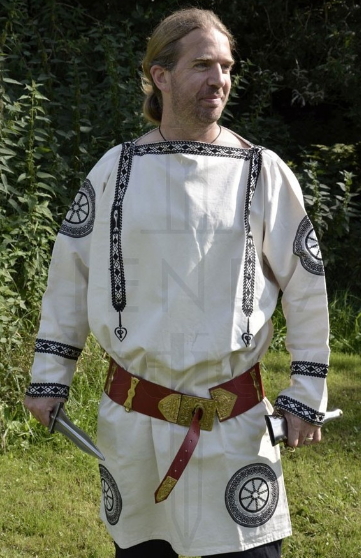
Models, sizes and recommendations for use
When choosing a model, consider its purpose, material, and finish. For strict recreations, use wool for thermal authenticity and linen for warm climates. For theatre or extended events, modern blends facilitate care. Also, consider the finish: dyed or applied stripes change the social perception of the garment.
If you are looking to buy an authentic Roman tunicata manicata for recreation or an event, in our online store we have different sizes, fabrics and finishes available. There you can compare materials, see size charts and choose the piece that best suits your historical replica.
Where to buy and available models
In our online store you will find a curated selection of manicata tunics with sizing explanations, materials, and detailed photographs. We offer advice on choosing the appropriate fabric and cleaning recommendations to extend the garment’s life.
Comparative table: types of tunic and uses
| Type | Sleeves | Distinctive feature | Worn by | Common color |
|---|---|---|---|---|
| Tunicata manicata | Short or elbow-length sleeve | Simple, sometimes visible belt | Civilians and daily use | White, beige, natural tones |
| Tunicata augusticlavica | Variable | Small side stripes | Officials and upper-middle classes | Neutral tones with dyed bands |
| Tunicata laticlavia | Short or long depending on occasion | Two wide purple stripes | Senators and high officials | Purple and white |
| Military tunic | Normally short | Simple and functional | Legionaries | Resistant and neutral colors |
Care and maintenance tips
To keep a manicata tunic looking historical, follow these practical recommendations: hand wash or delicate cycle with mild detergent; flat dry or hang, avoiding prolonged sun exposure; reinforce seams in areas of wear; iron at moderate temperature with a protective cloth on fine fabrics.
- Hand wash or delicate cycle with mild detergent.
- Flat dry or hang, avoiding direct sunlight.
- Reinforce seams in areas of wear for intense use.
- Iron at moderate temperature with a protective cloth.
If you buy a replica from our online store, you will find specific care instructions according to the chosen fabric. We also offer repair and adjustment services to adapt them to contemporary measurements without losing the historical line.
Interpreting the tunic today: fashion, recreation, and education
Today, the Roman tunicata manicata serves both for historical recreation projects and for theatrical pieces or reinterpretations in contemporary fashion. Maintaining fidelity in cut and proportions allows for authenticity; small adaptations like linings or discreet closures improve modern usability.
From archaeological research in Antinoe to the mosaics of Ravenna, the legacy of the manicata continues to inspire designers and enthusiasts. If your interest is educational, using correct replicas contributes to a richer understanding of Roman life: mobility, social stratification, and the role of clothing as symbolic language.
VIEW MORE ROMAN TUNICS | VIEW MORE HISTORICAL TUNICS FOR MEN | VIEW HISTORICAL TUNICS FOR WOMEN
The Roman tunicata manicata summarizes the balance between functionality and symbolism. Understanding its history, patterning, and materials allows you not only to recreate it precisely but also to appreciate how fashion functions as a mirror of society. If you are looking for pieces faithful to tradition and adapted to modern use, consult them in our online store and choose the one that best suits your project.


